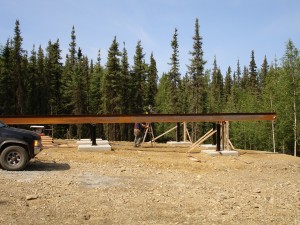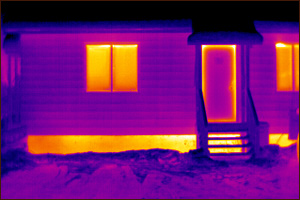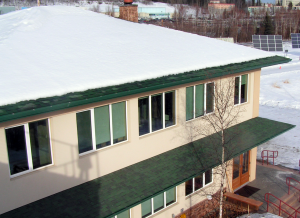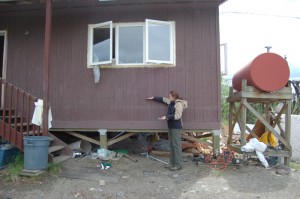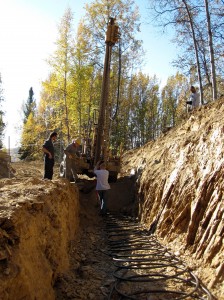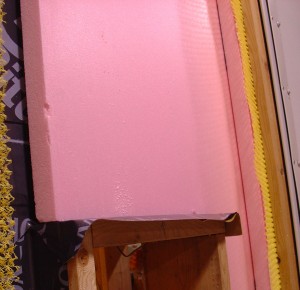Aaron Cooke, architectural designer at the Cold Climate Housing Research Center, describes the goals of the UAF Sustainable Village and Student Design Competition.
Tag Archives: cold climate housing research center
Do you need a vapor barrier on a raised floor?
Post and pad foundations are a common sight in Fairbanks, as they represent one of the least expensive approaches to building on unstable soils – of which we have no shortage. Usually the floor is raised several feet off of the ground, and air flows freely underneath.
It is standard practice in cold climate construction to install a vapor retarder on the “warm side” (indoors) of the exterior walls and ceilings. This keeps the water vapor generated in the living spaces during the cold seasons from entering the insulated cavities, where it can condense and lead to mold and rot. Installers typically use polyethylene plastic sheeting in a “6 mil” thickness, which is mandated by local building codes.
With post and pad construction, it may seem logical to also install plastic sheeting over the tops of the floor joists before laying down the subfloor sheathing. In some cases however, it can do more harm than good.
If any rainwater leaks through the joints in the subfloor before the roof is on, it will be stopped by the plastic, and the floor may not be able to dry out quickly enough to avoid mold and decay. The same risks hold true if liquids are spilled on the floor once the house is finished, or if a major plumbing leak occurs. The plastic also prevents the use of subfloor adhesive between the joists and sheathing, which is designed to prevent squeaks in the floor. Modern subfloors are usually sheathed with industry-standard ¾-inch tongue and groove exterior-rated plywood, or oriented strand board (OSB).
With post and pad construction, the subfloor sheathings are less at risk for moisture issues to begin with. That’s partly because warm indoor air leaves at the top and is replaced by outside air drawn in at the bottom, so water vapor moves upwards – away from the floor. In addition, the combination of thickness and types of glues used in ¾-inch plywood and OSB subfloor sheathings means they are less likely to absorb any moisture that might be forced into the house.
To minimize air leakage through the floor, the unsupported seams can be caulked with an adhesive sealant, such as a silicone, that bonds well with wood. The decision of whether to use or omit a plastic vapor retarder in floors using post and pad construction ultimately rests with the engineer or the local code official, who may have reasons specific to the project or building site.
Policy Researchers Head Southeast to Meet with Building Communities
CCHRC is presenting one of the keynote addresses at the Alaska Municipal League (AML) Summer Legislative Meeting in Sitka this week. The AML, a statewide advocacy organization of 140 municipalities, meets each summer to discuss common issues and set legislative priorities at the state and federal levels.
CCHRC Senior Researcher for Energy Policy, Dr. John Davies, will present on energy efficiency as a resource for the sustainability of Alaskan communities. This will be a great opportunity to advance discussion of state energy efficiency policy recommendations that are part of work CCHRC is performing under a contract with the Alaska Energy Authority. A long-term commitment to improving the energy efficiency of our buildings, appliances, and vehicles can reduce our need for energy by such large amounts that it should be considered as equivalent to large energy resources such as natural gas pipelines, hydroelectric dams, or coal-fired power plants.
Davies, along with Policy Research Director, Dr. Kathryn Dodge, will also visit Juneau and Ketchikan to meet with members of the building community about energy efficiency standards and the programs used to measure them. They will discuss and obtain feedback from builders, energy raters, and regulators on proposed policy recommendations, such as a statewide energy code, and present updates to a range of CCHRC programs. One agenda item will be AkWarm, an AHFC computer program used to model energy use in homes and commercial buildings. AkWarm’s calculations are based on insulation levels, air tightness, and other thermal characteristics, and it is used to certify building for loans, rebates, and other purposes.
Hot roofs, cold roofs, and common roof problems
In severe cold climates, roofs face two important challenges; retaining heat effectively, and controlling moisture trying to escape from the living space. The colder the weather and the longer the winter, the more pronounced the issues can become. Deficiencies and poor building practices that are overlooked in a more forgiving climate become very apparent here in Fairbanks. A basic understanding of your roof system and the challenges it faces can help to identify the sources of problems.
Roofs fall into two categories: “cold” and “hot.” They can suffer from the same ailments.
A properly constructed “cold” roof maintains a continuous air space between the underside of the roof and the insulation. This air space is designed to do two things. To some degree, it allows an exit path, through vents, for moist air that has leaked from holes in the ceiling vapor barrier into the insulation cavity. The space also creates a thermal break that helps prevent escaping interior heat from conducting directly to the roof’s underside, where it can cause the snow above to melt.
A “hot” or unvented roof relies on high levels of insulation to slow down heat transfer to the exterior. The other critical component in a hot roof system is a near-perfect vapor barrier that keeps moisture-laden air from entering the roof cavity, where it can become trapped.
If either type of roof fails to retain heat, one result is ice damming, a fairly common sight in Fairbanks in mid-winter. The classic symptoms are large icicles hanging off of eaves and exposed spots on the roof where snow has melted away. Roof problems are more pronounced in our climate because we have an increased “stack effect.” Rising warm inside air will try to exit the building through leaks at the ceiling level. To replace it, dense, cold, outside air is drawn through cracks in the bottom of the house like a chimney. The greater the temperature difference between inside and outside, the stronger the stack effect, amplifying the heat loss.
Water vapor abides by similar laws. During winter there is a huge imbalance between moist, heated indoor air and extremely dry, cold outdoor air. Because water vapor molecules by nature try to reach equilibrium, they will move through any vulnerable areas (including solid wood) to balance the moisture levels. This is called vapor drive. The greater the temperature difference, the more intense the vapor drive. When a house has high indoor humidity, the combination of stack effect and vapor drive can cause severe moisture problems inside the roof if it is poorly sealed. Gone unnoticed, this can lead to structural damage as well as mold and its accompanying health issues.
Whether your roof is hot or cold, three elements will keep problems at bay: good indoor moisture control, adequate insulation, and good sealing.
Emergency Housing at Crooked Creek
CCHRC is working on a housing project in the village of Crooked Creek that symbolizes a new way of responding to disasters in rural Alaska. The Kuskokwim River flooded the village in May, damaging or destroying half the homes in the town. The Alaska Division of Homeland Security and Emergency Management asked us to quickly design nine new energy efficient homes that could be built before winter.
We’ve created a design that is simple—it can be built by the many volunteers involved—flexible—it can be applied to homes with different sizes and floor plans—and tight—it can be heated with far less fuel than existing homes. The entire structure-walls, floors, and roof-will consist of a single system of 2x4s, so the homes will be quick and easy to build. This project is a milestone for rural housing because it adds an energy efficiency focus to the emergency-response building process. It recognizes that even replacement housing needs to be efficient, climate-specific, and durable.
We’re adapting techniques from prototype houses that we’ve tested in other villages, like Anaktuvuk Pass and Quinhagak, such as spraying foam insulation against metal siding to create a complete thermal envelope. The building sites will be elevated above the floodplain on gravel pads.
This is part of a larger plan with the Alaska DHS&EM to create regionalized, grab-and-go models that can respond to different disasters all over the state.
Our project partners include the Alaska DHS&EM, the Village of Crooked Creek, the regional corporation Calista, AVCP Regional Housing Authority, and Samaritan’s Purse.
How to heat your home using the cold ground
Our new report shows that ground source heat pumps are an effective and affordable technology for parts of Alaska, including Fairbanks, Juneau and Seward.
In this video, CCHRC researcher Colin Craven discusses how heat pumps work and what you have to think about before installing one in Alaska.
Is a hot water heater blanket always more efficient?
Putting a blanket on your hot water heater saves heat that you would otherwise lose to the air, a process known as jacket loss. But in some cases, allowing your hot water heater to shed heat could be more efficient than space heating. It depends on the type of hot water system and heating systems you have, how efficient they are, how much water you use, and many other factors.
Our building science research team is studying the interaction of these systems to determine when a hot water blanket is helping, or hurting, your overall home efficiency.
“Our theory is that it depends on the circumstances, and you can’t make an absolute general statement of one over the other on any of these questions,” says CCHRC building energy economist Nathan Wiltse.
We will simulate a highly efficient home, where any difference in energy use could likely be attributed to appliances. We will use energy models to test various configurations—water tanks versus on-demand heaters, high versus low water usage, boilers versus furnaces, the temperature settings of these systems, etc.
For instance, what if you have a radiant floor system set at 110 degrees, and a hot water heater set at 140 degrees? You may assume you’re better off using a hot water heater blanket, because it requires more energy to maintain the hot water tank at 140 than the floor loop at 110.
But if you have a 65-percent efficiency boiler and a highly efficient water heat, it may actually be better to allow those jacket losses. We won’t know til we run the simulations.
We’re going to create a matrix of the scenario results to show a number of the factors at work. We plan to share it sometime in January, so you can compare your own home heating information and see what might be the most efficient for your house.
Press Release: Report shows heat pumps economically viable in Alaska
Ground source heat pumps offer an economically viable heating option in some places in Alaska, according to a new report from UAF’s Alaska Center for Energy and Power and the Cold Climate Housing Research Center.
The study found that the systems, which extract heat from the earth, are technically and economically viable in areas with high heating costs and low electric costs. The report, funded by the Denali Commission, offers the first in-depth assessment of ground source heat pumps in Alaska.
“There recently has been quite a bit of excitement about ground source heat pumps, as people are seeking more affordable heating options. Our report helps explain the technology in the context of Alaska, and analyzes its potential throughout the state,” said co-author Colin Craven, head of product testing at CCHRC.
There are roughly 50 heat pumps in Alaska, including high-profile commercial installations at Weller Elementary School in Fairbanks and the Juneau Airport Terminal as well as several residential installations around the state. A heat pump transfers energy from the earth or water to use for heating or cooling. The system consists of underground tubing filled with heat-transfer fluid, an electric pump and a heat distribution system.
Researchers reviewed the industry in Alaska, interviewed ground source heat pump owners and assessed the performance and economic viability of the technology in five cities: Fairbanks, Anchorage, Juneau, Bethel and Seward. They compared the cost and performance of heat pumps with traditional heating systems in an average-sized new construction home in each city. They found that heat pumps could match or beat other heating systems in Fairbanks, Juneau and Seward.
“Even though the ground source heat pumps have high up-front capital costs, which is what deters people from installing them, they end up costing less over 15 years just because you save so much money on annual energy costs,” said Dominique Pride, graduate researcher at ACEP and co-author of the report.
The systems are most economical in Juneau and Seward, where heating oil is expensive and electricity costs are low. They also potentially make sense in Fairbanks, which has more expensive electricity than Southeast and Southcentral but also higher heating demand and costs, thus more room for energy savings.
The analysis found the pumps are not economical in Anchorage, which has low heating and power costs thanks to inexpensive natural gas. And they are not viable in Bethel and most of rural Alaska because of its extremely high electricity costs.
In addition to economics, researchers looked at cold climate considerations on system performance, including the impact of ground source heat pumps on soil, as extracting heat could create more permafrost if the ground temperature doesn’t recover in the summer. Researches plan to install a pump at the CCHRC next year to further study the effects and viability of the systems.
CONTACTS: Julie Estey, 907-590-0879. Molly Rettig, CCHRC communications coordinator, 907-450-1772, molly@cchrc.org. Marmian Grimes, UAF public information officer, at 907-474-7902 or via e-mail at marmian.grimes@alaska.edu.
How to Ant-Proof your House
Ant season is upon us once again. Carpenter ants are tenacious and once they start a nest, it can be hard to terminate. Prevention is the easiest counterattack: If you can keep them from establishing a foothold, you will be better able to protect home and property. Remove any wood scraps and tree stumps from around your home. Sheets of plywood, old tarps, pallets, and anything else that gives ground cover, particularly if it is moist, can provide a staging area for ants.
Once they gain entry to the house at ground level, ants will often start a nest in an area that is damp or prone to decay. Crawlspaces, basements, and any other moist spots will be especially attractive. They also like rim joists, areas where decks are attached, and areas around improperly flashed windows. Ants do not eat wood, but tunnel into it to make their nests. So rigid foam board, which is often used around foundations, also presents an appealing target. Even though ants prefer moist areas, they will also build nests in walls, floors, and even work their way into roofs.
Pick your poison
A mature colony will have a main nest and additional satellite nests. If the ants can be traced back to the main nest, then a localized dose of ant poison can be very effective. Many ant poisons are extremely toxic and if you are considering buying a product, research the long-term effects and handling precautions online. Chemical poisons may work well, but do not score high on a health and environmental scale, especially if pets or children could come into contact with them. Some insect poisons break down slowly and can be absorbed into the food chain by plants and animals or dispersed by rain and groundwater. So if you cannot locate the main nest, you should avoid sprinkling poisons liberally around the grounds in hopes it will kill the ants. Generally, chemical ant control should be left to a professional who can determine which product is best suited to a particular application.
Buying a bait
Many of the ant baits sold in local stores are designed for Lower 48 species of ants, which are primarily attracted to sweets. Carpenter ants are foragers that eat proteins (such as insects), so sweets will not appeal to them the same way. Look for bait specifically for carpenter ants on the shelf–it can be very effective.
If you buy an ant bait station and leave it exposed, it may attract pets, squirrels, voles, and other animals. Before you begin an ant attack, check with a local exterminator. Some may have access to good carpenter ant baits and contact poisons that are not available in stores.
When it comes to non-toxic products, diatomaceous earth is available at many feed and garden stores. It acts as a physical killer rather than a chemical killer by working its way into the ants’ breathing tubes and joints. It can be transferred among ants when they clean each other. It will do little good putting it on individual ants, you must find a nest.
Ants can create problems in every part of your home, which can be very expensive to repair. The sooner you get rid of them, the better. For more information on combating carpenter ants, visit the UAF Cooperative Extension Service at www.uaf.edu/ces/.
Which energy efficiency investments are best for my house?
That’s what an energy model will tell you.
How much insulation to use is one of the most common questions in the construction industry–among both contractors and homeowners. A steady increase in energy prices, along with growing material costs, makes it important to find the sweet spot between energy efficiency and affordability.
The Alaska Housing Finance Corporation provides standards, called Building Energy Efficiency Standards, or BEES, for different regions of Alaska to help guide these decisions. Home builders using AHFC mortgage loans must comply with these standards, but they also provide a good reference for anyone building in Alaska.
An energy model will tell you if you meet these standards. It’s a computer modeling program that runs a series of heat-loss and performance calculations for every single component of your house. You plug in the dimensions and construction details of all the exterior walls, roof, windows, foundation and floor, along with info about your heating and electrical systems, and you end up with a model of your home’s performance. The program also factors in climate data. You can change insulation values, construction types, heating appliances, and fuel prices to test a variety of conditions.
The best time to do the modeling is before you build, as it gives you the most flexibility to make changes. The best approach is to hire a state-certified energy rater to plug your house plans into the program, which should run between $350-$700 (but probably toward the lower end). You are required to get an energy rating anyway if you are using an AHFC funded mortgage loan to make sure you meet their standards. If you want to try energy modeling yourself, you can download a public copy of the AK Warm modeling program here (the one used in the state of Alaska).
Energy modeling is a powerful tool that can provide long-term savings and peace of mind with minimal up-front investment. Remember, though, that occupant behavior and awareness will also have a great impact on your home’s performance. A house bursting at the seams with teenagers will perform differently than the same one occupied by a retired couple.
